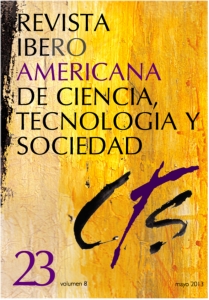Tiempo y nuevas tecnologías desde la perspectiva de la teoría de sistemas
DOI:
https://doi.org/10.52712/issn.1850-0013-643Palabras clave:
temporalidad, Luhmann, medios, comunicaciónResumen
Según el parecer de muchos teóricos, pero también de los legos, la aparición de las nuevas tecnologías de la información y la comunicación (TIC) ha generado profundas transformaciones en la forma de concebir y de experimentar cotidianamente la relación entre el tiempo y el espacio. En el siguiente trabajo se pretende problematizar esta relación entre las TIC y la temporalidad, tomando como marco teórico la teoría de sistemas desarrollada por Niklas Luhmann. Para poder iluminar tal articulación, será necesario comenzar por una relectura de los teóricos que ya han comenzado a tratar la problemática. Al mismo tiempo, también se hará indispensable reconstruir la posición luhmanniana respecto del tiempo y de las mismas TIC, cuestión, esta última, que el autor pudo tratar de manera muy somera. Sobre esta base y apoyándose en los resultados de investigaciones empíricas, se trabajarán las transformaciones temporales que implica para la comunicación la emergencia de las TIC como medio. Como corolario de esta indagación, se observarán también las repercusiones que la problemática antes expuesta provocaría sobre las conciencias.
Descargas
Citas
BAECKER, D. (2007): “Communication With Computers, or How Next Society Calls for an Understanding of Temporal Form”, Soziale Systeme, vol. 13, nº 1+2, pp. 409-420.
BITTMAN, M.; BROWN, J. y WAJCMAN, J. (2009): “The Cell Phone, Constant Connection and Time Scarcity in Australia”, Social Indicator Research, vol. 93, pp. 229-233.
CASTELLS, M. (2010): The Rise of the Network Society, The Atrium, John Wiley and Sons.
CASTELLS, M.; FERNANDEZ-ARDEVOL, M-; LINCHUAN QIU, J. y SEY, A. (2004): The Mobile Communication Society: Across cultural analysis of available evidence on the social uses of wireless communication technology, Los Angeles, University of Southern California.
ELCHARDUS, M. (1988): “The Rediscovery of Chronos: The New Role of Time in Sociological Theory”, International Sociology, vol. 3, nº 1, pp. 35-59.
GIDDENS, A. (1984): The Constitution of Society. Outline of the Theory of Structuration, Oxford, Polity Press.
GLEICK, J. (1999): Faster. The Acceleration of Just About Everything, Nueva York, Random House.
GLEICK, J. (1990): The Consequences of Modernity, Oxford, Polity Press.
GUMBRECHT, H. U. (2001): “How is Our Future Contingent? Reading Luhmann Against Luhmann”, Theory Culture Society, vol. 18, nº 1, pp. 49-58.
HASSAN, R. (2003): The Chronoscopic Society. Globalization, Time and Knowledge in the Network Economy, Nueva York, Peter Lang Publishing.
JAUREGUIBERRY, F. (2007): “Les téléphones portables, outils du dédoublement et de la densification du temps : un diagnostic confirmé”, Tic & Société, vol. 1, nº 1, pp. 79-103.
LASH, S. (2002): Critique of Information, Londres, Sage Publications.
LASH, S. y URRY, J. (1994): Economies of Signs and Space, Londres, Sage Publications.
LATOUR, B. (1997): “Trains of thought—Piaget, formalism and the fifth dimension”, Common Knowledge, vol. 6, nº 3, pp. 170–191.
LEONG, S.; MITEW, T.; CELLETTI, M. y PEARSON, E. (2009): “The question concerning (internet) time”, New Media Society, vol. 11, nº 8, pp.1267-1285.
LUHMANN, N. (1976): “The Future cannot Begin: Temporal Structures in Modern Society”, Social Research, vol. 43, nº 1, pp. 130-152.
LUHMANN, N. (1984): Soziale Systeme. Grundriß einer allgemeinen Theorie, Frankfurt a.M., Suhrkamp Verlag.
LUHMANN, N. (1996): La ciencia de la sociedad, México DF, Anthropos.
LUHMANN, N. (1997a): Die Gesellschaft der Gesellschaft, 2 Bd. Frankfurt a.M., Suhrkamp Verlag.
LUHMANN, N. (1997b): “La cultura como concepto histórico”, Historia y Grafía, vol. 8, pp. 11-33.
LUHMANN, N. (1998): Sistemas Sociales. Lineamientos para una teoría general, Barcelona, Anthropos.
LUHMANN, N. (1999): “Tiempo del mundo e historia sistémica”, Inguruak, vol. 23, pp. 13-54.
LUHMANN, N. (2000): La realidad de los medios de masas, Barcelona/México DF, Anthropos/Universidad Iberoamericana.
LUHMANN, N. (2007): La sociedad de la sociedad, México DF, Herder.
LUHMANN, N. (2009): „Gleichzeitigkeit und Synchronisation“, Soziologische Aufklärung 5. Konstruktivistische Perspektiven, Wiesbaden, VS Verlag, pp. 92-125.
MACKENZIE, A. (2005): “Protocols and the irreducible traces of embodiment: the Viterbi algorithm and the mosaic of machine time”. Disponible en: http://www.lancs.ac.uk/staff/mackenza/papers/mackenzie-algorithmic-time.pdf. Consultado el 17 de agosto 2011.
MARTON, A. (2009): “Self-Referential Technology and the Growth of Information: From Techniques to Technology to the Technology of Technology”, Soziale Systeme, vol. 15, nº 1, pp. 138-159.
NASSEHI, A. (1994): “No Time for Utopia: The Absence of Utopian Contents in Modern Concepts of Time”, Time Society, vol. 3, nº 1, pp. 47-78.
NIE, N.; HILLYGUS, S. y ERBRING, L. (2002): “Internet Use, Interpersonal Relations, and Sociability a Time Diary Study”, en B. Wellman, y C. Haythornthwaite (eds.): The Internet in Everyday Life, Oxford, Blackwell Publishers, pp. 215-243.
SCHWANEN, T. y KWAN, M. (2008): “The Internet, mobile phone and space-time constraints”, Geoforum, vol. 39, pp. 1362-1377.
SPENCER BROWN, G. (1972): Laws of form, Nueva York, The Julian Press Inc.
Descargas
Publicado
Cómo citar
Número
Sección
Licencia
Derechos de autor 2024 CC Attribution 4.0

Esta obra está bajo una licencia internacional Creative Commons Atribución 4.0.
Todos los números de CTS y sus artículos individuales están bajo una licencia CC-BY.
Desde 2007, CTS proporciona un acceso libre, abierto y gratuito a todos sus contenidos, incluidos el archivo completo de su edición cuatrimestral y los diferentes productos presentados en su plataforma electrónica. Esta decisión se sustenta en la creencia de que ofrecer un acceso libre a los materiales publicados ayuda a un mayor y mejor intercambio del conocimiento.
A su vez, para el caso de su edición cuatrimestral, la revista permite a los repositorios institucionales y temáticos, así como también a las web personales, el auto-archivo de los artículos en su versión post-print o versión editorial, inmediatamente después de la publicación de la versión definitiva de cada número y bajo la condición de que se incorpore al auto-archivo un enlace a la fuente original.











